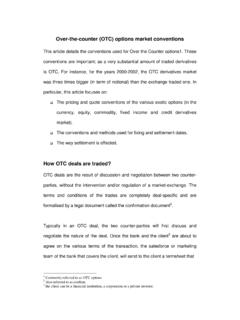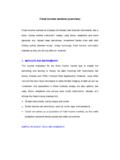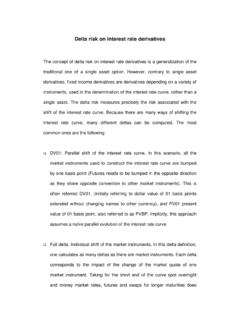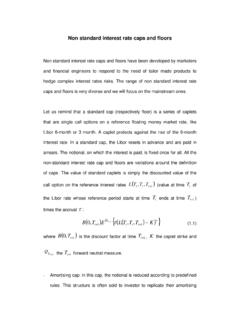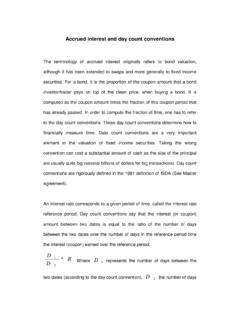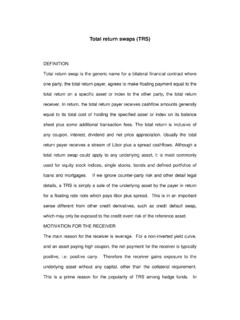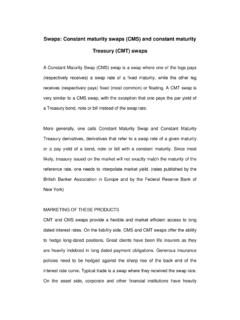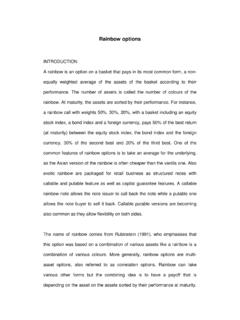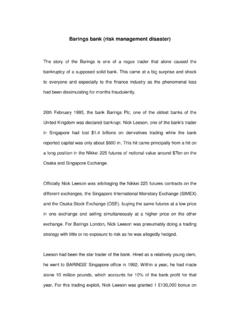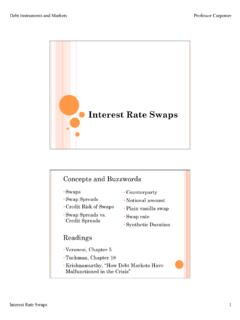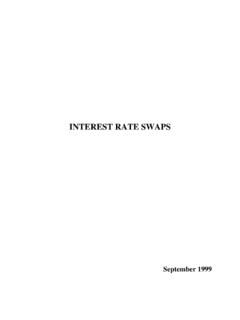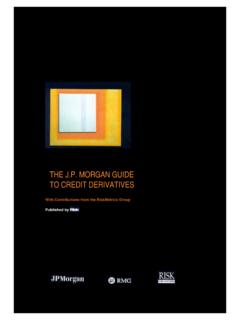Transcription of Swaps: basis swaps - Eric Benhamou
1 swaps : basis swaps INTRODUCTION Strictly speaking, a basis swap or a floating/floating cross currency basis swap is a swap in which two streams of money market floating rates of two different currencies are exchanged. In contrast to a standard interest rate swap fixed for floating, notional are exchanged at the starting of the swap and exchanged back at termination. Typical example of a basis swap is swapping dollar Libor versus Yen Libor. By extension, basis swap refers to floating/floating (cross currency or not) swap in which two streams of floating rates are exchanged, regardless if these floating rates are in the same currency. Typical example of basis swap in the same currency are swapping dollar Libor for floating commercial paper, Prime Treasure bills or Constant Maturity Treasury rates or even 90 days Dollar Libor for 180 days Dollar Libor.
2 In the case of a swap in the same currency, notional do not change hands as there is no currency exposure. As far as the cross currency swap market is concerned, basis swap enables traders investor to swap their interest rate risk exposure in another currency. basis swap market reflects the global demand for swapping from one currency into another as well as the credit quality of the central bank. This is a huge market with billions of notional transaction every day. One of the most active markets is the Yen dollar market. When an investor wants to swap his currency exposure into another one, he may go to the forward foreign exchange markets. However, this market is only liquid up to 2 to 3 years, after which the basis swap market is taking over. basis swap market is an important component to build a cross currency swap market used for cross currency swap pricing as well as other cross currency type transaction.
3 basis swap should not be confused with: General Cross currency swap: the intersection between basis swap and cross currency swap lies in the floating for floating cross currency swap. However, a basis swap is not necessarily based on two currencies, while a cross currency swap is not necessarily floating for floating but can be fixed for floating, floating for fixed or fixed for fixed. Quanto or diff swap which implies to pay in two currencies but with the same notional and no exchange of notional. Like any standard swap, a basis swap can have tailor made notional such as amortising or accreting or roller coaster notional (see swaps types, taxonomy of) PRICING METHODOLOGY The basis is more pronounced on the USD/JPY market hence we will examine the case of the 10year basis swap paying US Dollar 3 month Libor Flat Libor versus receiving JPY 3 month Libor plus a spread.
4 The market quotes this spreads as being 15 basis point running. This means that to enter into a swap where one would pay US Dollar 3 month Libor Flat Libor, one would require receiving JPY 3 month Libor plus 15 basis points. At first sight, this may look strange to someone accustomed to plain vanilla interest rates as she has been always taught that a floating leg should always be at par. Hence the two legs, USD 3 month Libor and JPY 3 month Libor should be equal. However, one has to bear in mind that interest rate swap Libor are approximate averages of offer rates from different banking institution. Libor rates bare credit and liquidity risk. Hence a USD Libor rate may have a better credit and liquidity quality as the JPY Libor fixing, hence the spread required by USD investors to receive a worst currency. Also basis swap markets is very much driven by supply and demand for issuance.
5 A spread of 15 basis points means that there is little demand to receive JPY Libor, hence one has to pay a premium to convince investors to swap. To build a consistent methodology for pricing, one can take two approaches: Single interest rate curve method: Build an interest curve that uses all the constraint of the forward foreign exchange market and the basis swap market to price consistently basis swap market. Although simple, this method has the disadvantage to oblige the trader to change curve when pricing a JPY leg in the JPY market as opposed to pricing a JPY versus USD swap. Interestingly, one can look at the discount factor difference between the JPY normal bootstrapped interest rate curve and the basis swap interest rate curve to quantify the basis swap market effect. Jpy Libor curve and spread curve used to account for the basis swap market.
6 One has first to create the normal interest rate swap curve by bootstrapping the domestic market. Then using this curve, one can bootstrap another curve called the basis swap spread curve that adjusts for credit quality to get the JPY basis swap leg (JPY plus 15 basis points) to be at par. Basically this spread curve says that a 3 month JPY Libor leg is not at par and one need 15 basis points to bring it at par. When pricing in the JPY domestic market, one only uses the standard interest swap curve. In this market, a leg paying JPY 3 month Libor is at par. When pricing a cross currency swap JPY versus USD, one has to apply to the JPY curve the basis swap spread curve to price correctly the JPY leg. More generally, one can build an interest rate infrastructure that uses standard Libor curve plus a funding curve or spread curve to account for various market effects like credit and counterparty risk, basis swap market, CMS and CMT adjustment and etc.
7 The existence of this basis swap curve implies the same swap could be a par for a JPY investor while not a par for a USD investor as they have a different view on credit quality of the Bank of Japan. Table 1: Cash flows of a basis swap Entry category: swaps Scope: single and cross-currency basis swaps Related articles: swaps types, taxonomy of; swaps : interest rate swaps (IRS); swaps : cross-currency swaps (CCS) Eric Benhamou1 swaps Strategy, London, FICC, Goldman Sachs International 1 The views and opinions expressed herein are the ones of the author s and do not necessarily reflect those of Goldman Sachs JPY notional USD notional
